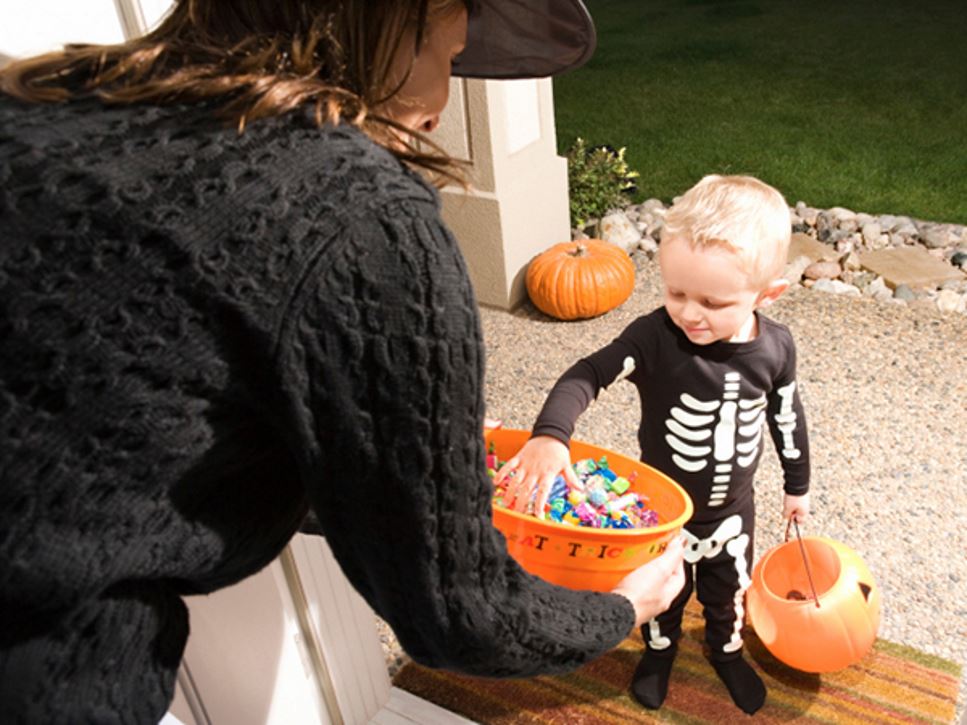Halloween can be a season of costumes, scary movies and candy. But for parents of kids with food allergies, there is a different reason to be frightened. Six of the top allergens are in high circulation around Halloween. Wheat, milk, soy and even egg are used in many chocolates, caramels and fruit chews. Even more candies are made with or processed on the same equipment as peanuts and tree nuts, such as walnuts, almonds and cashews. Even small amounts of these allergens can cause an anaphylactic reaction in kids who are allergic to them. Parents also should be on the lookout if their child is allergic to sesame. Sesame oil may make an appearance in candy corn, and sesame seeds are an ingredient in some treats.
Parents should consider discussing with their children the allergens that may be hidden in specific foods, including Halloween treats. Additionally, talk to your children about strategies for when they are attending parties and trick-or-treating, including what to do if they think they are having an allergic reaction. Be sure that a responsible adult is at the party and aware of your child's allergies.
Consider these tips for a safe, allergen-free Halloween.
Read All Labels
This is good advice for all candy, but especially true for miniatures or snack sizes, which sometimes are processed in a different facility than regular-sized candy. The Food Allergen Labeling and Consumer Protection Act requires that all FDA-regulated foods list sources of the top major allergens in the ingredients list with common names of the allergen included in parentheses — such as "lecithin (soy)" or "whey (milk)." Or, an alternate statement to look for either next to or right after the ingredients is "Contains …" followed by the source of the allergen, such as “Contains Wheat.” The Food Allergy Safety, Treatment, Education and Research Act signed into law on April 23, 2021, named sesame as the ninth major food allergen in the U.S., requiring it to be declared on food labels beginning January 1, 2023.
Some packaging includes a note following the ingredient list that states "May contain …" and then the name of the allergen. However, this labeling is completely voluntary, so a product may or may not include that statement or the allergen. Play it safe and read the ingredients list every time, even for products you typically consider "safe." Since many individual bite-size candies don't contain an ingredients list, look up the ingredients for specific products online to ensure they are safe for your child to eat. If a product is homemade or has no label, throw it out.
Talk to Your Neighbors
Neighbors and friends may want to buy allergen-free candy but don't know what to buy, or may not even know that your child has a food allergy. Share with them what to look for when purchasing candy, or even offer to provide them with "safe" candy they can hand to your trick-or-treater.
Look for the Teal Pumpkins
Created by Food Allergy Research & Education in 2014, the Teal Pumpkin Project is a campaign to raise awareness of food allergies and provide safe options for trick-or-treaters with food allergies. Participants pledge to put a teal pumpkin outside their homes, indicating they have safe, non-food treats available.
Instill the "Always Ask First" Rule
Carry candy for young children while trick-or-treating, remind children not to share food and encourage them to ask you before eating anything. Kids should learn to always read the label before eating any packaged food or candy. If in doubt, throw it out, trade it or give it away. It's helpful to make a list of packaged treats that are safe based on individual allergies.
Safe at School
If your child's class celebrates Halloween, take an active role in preventing the risk of a dangerous allergic reaction. Talk to the teachers in advance, volunteer to organize the party, offer to bring the treats or non-food goodies or plan to attend in person and double-check that your child's emergency action plan and epinephrine pens are up-to-date.
Trade or Donate
Before setting out trick-or-treating, make a plan with your child to swap any unsafe candy for another treat, such as a safe candy, book or small toy. Or, donate candy to the local food pantry or other charitable organization.
Start a New Tradition
Host a costume party at your house, so you are in charge of treats. Or, forgo candy altogether and offer trick-or-treaters a variety of non-food items such as stickers, glow sticks, bouncy balls or fake mustaches.
Find a Nutrition Expert
Looking for credible nutrition information and recommendations? The Academy of Nutrition and Dietetics' network of credentialed food and nutrition practitioners are ready to help!


